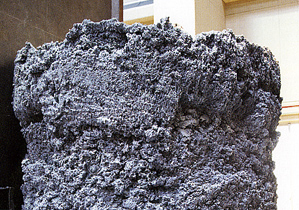
Osaka Titanium Technologies is focusing on stable procurement of titanium sponge materials by negotiations to conclude several-year contracts or cultivations for new supply sources. Procurement of titanium sponge materials such as rutile and slug is currently difficult under severe material scrambles with pigment makers. Material cost has jumped by more than 50% in the latest year. Osaka Titanium Technologies aims to put material cost upsurge on the selling price of rolled titanium products in next year contracts.
Titanium sponge materials are originally mineral sand or ilmenite ore. Mineral sand and ilmenite ore are refined to synthetic rutile or high grade slug in the ore producing countries. Osaka Titanium Technologies has imported synthetic rutile and high grade slug from Canada, India, Australia and South Africa. Rutile and slug consumption for high grade titanium sponge represents only 3-5% in the global whole titanium material consumption. The rest materials are used for pigments and China is the largest material consumer. In China, the demand is expanding by 20% per year. Thus material supply for high grade titanium sponge is tightening. Osaka Titanium Technologies is now negotiating with overseas material suppliers to conclude several-year contracts for stable procurement. At the same time, the firm is seeking diversification of material supply sources. Rutile and slug production has recently started in Vietnam and Mozambique while ore development projects are progressing in Peru, Senegal and Kenya. Materials account for 24-25% in total productive cost of titanium sponge. Material cost has jumped by more than 50% since 2010. Osaka Titanium Technologies raised its selling price of rolled titanium products by around 5% for 2011 shipment. The firm may be forced to launch wider price hike for 2012 shipment. The firm is currently accelerating output capacity expansion for titanium sponge. The firm finished refreshment of a small-size reduction furnace 2 months ahead of the original schedule and raised the sponge output capacity to 37,000 tonnes per year in July. The third-phase capacity expansion is also progressing steadily and the productive capacity is expected to reach 40,000 tonnes per year at the end of this year.











